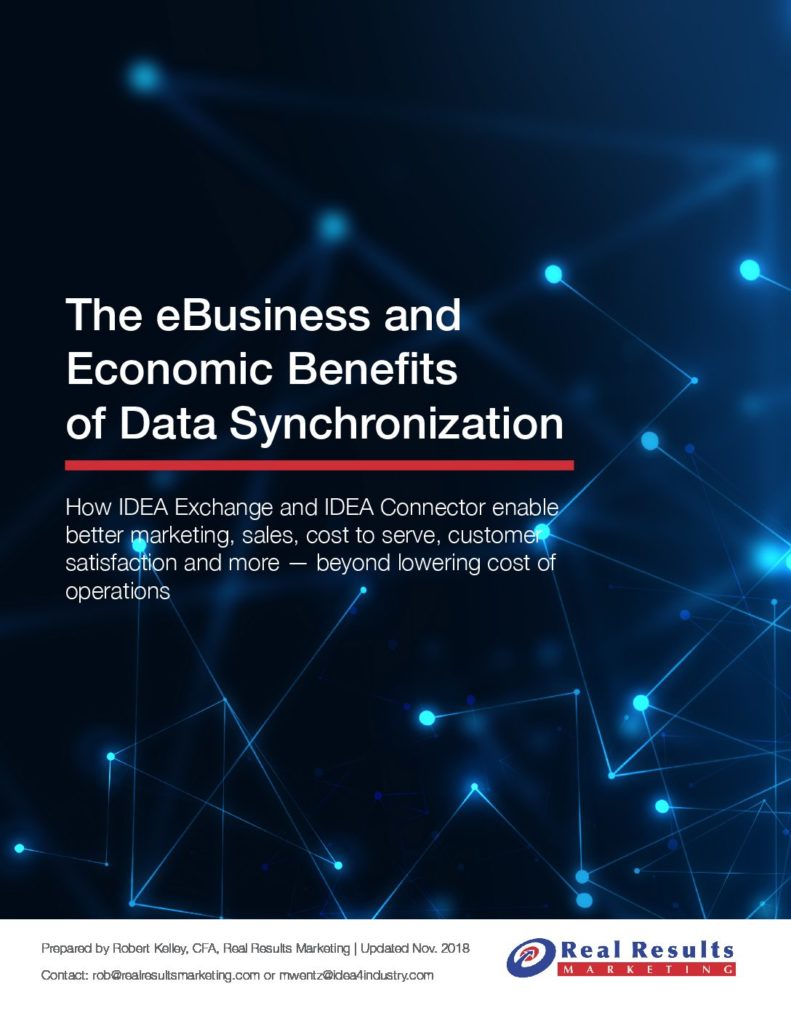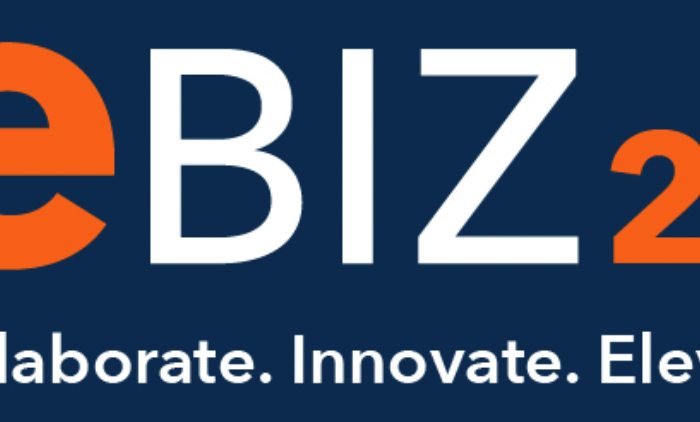Research Reaffirms IDEA Benefits Bottom Line
IDEA, the Industry Data Exchange Association, which was co-founded by NAED and NEMA in the late 1990’s, undertook one of the larger challenges in the industry and has been navigating change for the past 20 years. The challenge is bringing some semblance of “order” to product data. The initial intent was to help streamline ordering processes (this was “pre-eCommerce!”) so that distributor and manufacturer “ordering” systems could talk to each other and minimize / eliminate errors. (And, in the interest of full disclosure, I was involved in some of the early distributor recruiting for IDEA when I was at IMARK and sat on the first Marketing Committee.)
Imagine corralling 2500-3000 distributors and countless suppliers to agree upon standards to conduct business. Getting competitors in a room to agree upon product attribute standards kept NEMA lawyers busy. Eventually processes were agreed upon and adoption slowly ensued as there was some “chicken and the egg” issues (“Should I join if I can’t get all my content in one place?” and “Why populate if not all my distributors are downloading data?”) The reality is that it needed to be an evolutionary process. One that required forward thinking and some risk taking.
And then came eCommerce and the need for more product content … and from departments that were never involved in product content.
The need, and usage, of content appears to have no end, so IDEA has had to continuously evolve to meet its customers’ needs, albeit it’s tough to be proactive when there is joint ownership by associations.
But more distributors and manufacturers than ever before are benefiting from IDEA and look to it as their central repository for product data to power their business, especially their ERP system, as well as a low cost EDI processor through IDEA Exchange.
And while it has competitors, electrical distributors and electrical manufacturers can look at IDEA as another way to support the electrical industry.
Recently IDEA commissioned a white paper on the benefits of IDEA. The first IDEA cost/benefit analysis was done pre-interest in eBusiness. This version includes potential marketing / sales generation benefits for companies that are selling online.
In the words of IDEA …
Distributors and manufacturers are facing accelerating change and increased customer expectations. As a result, many companies are investing in eBusiness initiatives to automate transactions with trading partners, synchronize product data, and enable electronic procurement via websites, punchouts and other automated purchasing methods.
To help with decision making, IDEA recently published a new white paper, “The eBusiness and Economic Benefits of Data Synchronization.” This research builds upon prior research conducted by IDEA years ago. The takeaway … synchronized data makes you easier to do business with AND more profitable.
Operational & Revenue Improvements
The research confirmed that synchronized digital product information brings operational efficiency which translates into improved throughput and financial benefits. For example, IDEA Connector drives data quality and integrity throughout the organization and your supply chain; it dramatically lowers ordering costs, resulting in cost savings that impact your bottom line and directly increase profits.
Synchronized product data also improves end user customer loyalty and satisfaction, marketing efficiency and return on investment (ROI), as well as improving the ability to upsell and cross-sell more products.
The research found that the financial return from IDEA Connector and IDEA Exchange technologies far exceeds the costs of implementing and maintaining the solutions. Bottom-line financial benefits range from 5-10 times the investment over five years, with even greater potential for larger distributor and manufacturer organizations.
Transforming from Order Processing to eBusiness
Over the past two decades, the electrical industry has matured in its electronic initiatives, growing from order processing to eBusiness, which includes eCommerce as well as a wider range of business processes. Accordingly, the focus of IDEA technologies have grown in scope and function.
- IDEA Connector is a continually updated database that enables manufacturers to securely share accurate and timely product and pricing data with distributors and other wholesale trading partners from one centralized location and in one standardized electronic format. This promotes data synchronization and lowers supply chain costs. IDEA Connector now represents product data for more than 2.5 million SKUs (2,000+ manufacturer brands and 85% of industry SKUs) and serves over 8,000+ distributor locations.
- IDEA Exchange reduces costs and increases efficiencies in the customer lifecycle and is the automation of the quote-to-cash cycle using electronic data interchange (EDI). It enables suppliers to exchange eBusiness documents with their trading partners faster, easier and more securely than with traditional Value-Added Networks (VANs) or paper-based methods. IDEA Exchange connects nearly 300 manufacturers and distributors, processes over 6.5 million transactions and nearly 10.5 million kilocharacters each month.
Growing Revenues and Profits: eBusiness Modeling

The white paper provides a five-year projection on the benefits of implementing IDEA Connector and IDEA Exchange, using modest assumptions for distributors and manufacturers of various sizes. For full details, download the white paper.
Sales Personnel Effectiveness Improvements
- Better product data frees up time for customer-facing personnel, like sales and customer service representatives (CSRs).
Product Management Productivity Improvements
- Personnel responsible for creating and maintaining product data are able to manage more products and use product content more effectively.
Operations Efficiency Improvement
- This measures the impact of processing more transactions without requiring additional personnel.
Reduction in Errors
- Up-to-date and accurate product data reduces or eliminates ordering errors. The model measures the overall cost of errors to the business including loss of productivity, delays and lost business.
Marketing Lift
- Marketing activities, including websites, fueled by high quality product data can have a higher return by improving search performance, customer access to needed information, and opportunities to upsell and cross-sell.
Five-Year Benefits
The benefits are projected as a five-year cumulative benefit. This approach illustrates the positive impacts of the solutions for metrics like sales revenue, customer growth / retention and bottom-line profitability.
By combining the product information benefits of IDEA Connector with the process automation benefits of the IDEA Exchange solution, the operational benefits from a streamlined supply chain improves the business of all participants, from manufacturers that source products to distributors that make procurement easy to the ultimate end-customer organizations that are able to serve their customers better than ever before.
Some thoughts:
- Why IDEA? Because distributors need to reduce their operating costs. Any opportunity to reduce operational costs and improve productivity should be reviewed, especially if repetitive, non-value-added functions can be automated. To improve profitability, distributors need to drive down costs as gross margins are extremely difficult to significantly increase.
- IDEA Exchange is a low-cost industry solution. In fact, IDEA has a calculator to help evaluate cost.
- The IDEA Connector (what used to be called the IDW for Industry Data Warehouse) has 2.5 million SKUs. While it may not have everything distributors need, no single source does because there are many small to mid-sized distributors in the industry as well as large companies that sell a small portion of their product offering to the electrical industry. But, 85% is compelling. And the Connector has all of the fields needed to power a distributor’s ERP system.
- From a manufacturers sales / rep viewpoint, understanding IDEA, IDEA Connector and how your manufacturer populates the system (and updates it) is important so that you can advise your distributor and ensure that they get the best information from your company. Quality product information should have a correlation to your customer service issues.
IDEA was a good idea years ago. It still is. And those who are actively using it have seen financial and operational benefits.
- If you’re using, what has been your experience?
- Not using? Why?
- And what does IDEA need to do next to help you meet tomorrow’s needs?
- Not using? Why?
- And what does IDEA need to do next to help you meet tomorrow’s needs?

























